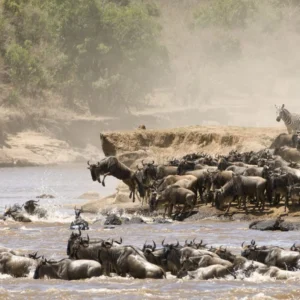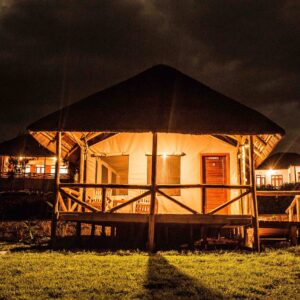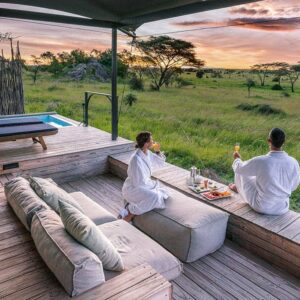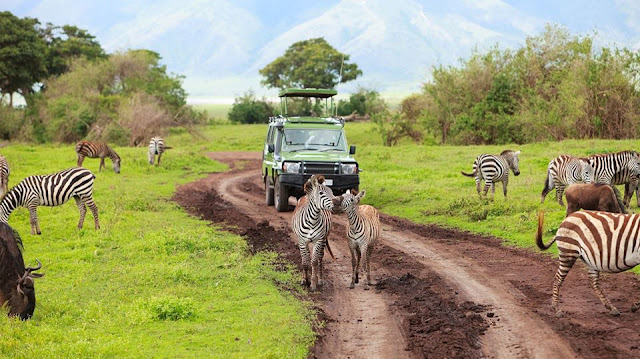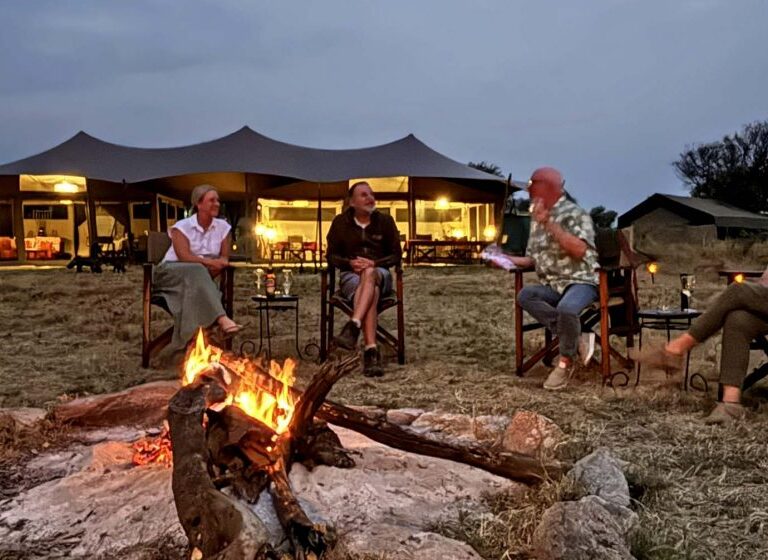To plan a budget-friendly safari in East Africa, consider traveling during the shoulder or low seasons, opting for private customized camping, and booking with local tour operators. Focus on affordable accommodations, pack light, and be flexible with your itinerary to maximize your savings. East Africa conjures images of endless savannahs, majestic wildlife, and breathtaking sunsets. For many, a safari here is a lifelong dream, but the perceived high cost can often make it seem unattainable. The good news is that an unforgettable East African safari doesn’t have to break the bank. With strategic planning and a few insider tips, you can experience the magic of the wild without emptying your wallet. Here’s how to plan a budget-friendly safari in East Africa:
1. Choose Your Destination Wisely: Kenya or Tanzania (and Beyond!)
Both Kenya and Tanzania offer iconic safari experiences, but their costs can vary significantly. Kenya typically has lower prices for park fees and accommodation, especially outside the Maasai Mara during the migration seasons. Tanzania is renowned for the Serengeti and Ngorongoro Crater, and while it can be pricier, strategic planning can yield budget options. Consider lesser-known parks like Amboseli or Tarangire in Tanzania for a more affordable experience. While both Kenya and Tanzania offer incredible safari experiences, the costs can vary.
Tanzania: Home to iconic parks like the Serengeti and Ngorongoro Crater, Tanzania is often considered pricier due to higher park fees and a more developed luxury safari infrastructure. However, budget options still exist, especially through camping safaris.
Kenya: Kenya, with its famous Maasai Mara, generally offers more diverse budget safari options, especially for group tours. Parks like Lake Nakuru and Amboseli can also be more accessible on a budget.
Uganda and Rwanda: If gorilla trekking is on your bucket list, be aware that permits are a significant cost ($800 in Uganda, $1,500 in Rwanda, $400 in Congo). However, other wildlife safaris in these countries can be more affordable.
Hidden Gems: Consider less-visited parks within Kenya or Tanzania, such as Tarangire or Lake Manyara in Tanzania, or Samburu National Reserve in Kenya. These often have lower fees and fewer crowds, yet still offer incredible wildlife viewing.
2. Timing is Everything: Embrace the Low and Shoulder Seasons
The peak safari season (roughly June to October, and December to January) coincides with the dry season, offering optimal wildlife viewing as animals congregate around water sources. However, this is also when prices for flights, accommodation, and tours are at their highest due to demand. The high season for safaris often sees inflated prices and crowded parks. Opting for the low season (April to June and November) or shoulder seasons (January to March and September to October) can decrease costs substantially. Not only will you encounter fewer tourists, but you’ll also find better deals on accommodations and activities during these times.
Low Season (Green Season): Traveling during the rainy season (typically April to May and parts of November) can significantly reduce costs. Lodges and camps offer discounted rates, and parks are less crowded. While some roads might be muddy, the landscapes are lush and green, and birdwatching is superb. Wildlife is still abundant, and you might even witness calving season, a truly special experience.
Shoulder Season: The periods just before or after peak season (e.g., January-March, November) offer a good balance of decent weather and African safari on a budget at lower prices. You still get good wildlife viewing without the peak season crowds and costs.
3. Private Customized Safaris and Overland Tours
Private, customized safaris and overland tours offer flexibility and personalized experiences in destinations like Tanzania. These tours allow for tailored itineraries, private vehicles, and dedicated guides, ensuring a unique adventure focused on individual preferences. Overland tours, often in custom-built trucks, take travelers through diverse landscapes and offer a different kind of adventure.One of the most effective ways to cut costs is to share them.
Look for private customized safari options or overland tours that mix independent travel with guided experiences. These tours often provide excellent value, as they can include transportation, meals, and park fees at a lower rate than booking separately.
Overland Tours: These longer, more adventurous tours typically involve traveling in a custom-built safari truck with the best affordable African safari holidays. They often include camping accommodation and cover multiple countries, offering an immersive and budget-friendly way to see East Africa.
4. Accommodation: Embrace Camping and Budget Lodges
Accommodation is a significant portion of safari costs, but you can save by choosing camping or budget lodges. Many national parks have affordable campsites that offer close-up wildlife experiences. planning a budget-friendly African Safari, staying in budget lodges outside park boundaries can also provide comfort without the hefty price tag. Your choice of accommodation will be the single largest factor in your safari budget.
Camping Safaris: For the most budget-friendly option, embrace camping. Many national parks have designated public campsites with basic facilities (toilets, showers). Some tour operators provide all camping equipment, including African Safari Budget Breakdown comfortable tents, mattresses, and even a chef. This offers an authentic, Affordable African Safari Packages wilderness experience, often with the sounds of the bush right outside your tent.
Budget Tented Camps & Lodges: These offer a step up from basic camping, providing permanent or semi-permanent tents or rooms with proper beds and often en-suite bathrooms. They offer comfort without the luxury price tag of high-end lodges. Look for options just outside the park gates, which can be considerably cheaper than staying inside the park.
Mix and Match: Consider an affordable all-inclusive African safari combining different accommodation types. For example, spend a few nights camping for the authentic experience and then treat yourself to a night or two in a mid-range lodge for a bit more comfort.
5. Choose a Local Tour Operator: Cut Out the Middleman
Selecting a reputable local tour operator can save you money while supporting the local economy. Local operators often have deeper insights into the best offers and can provide a more personalized service. They tend not to charge the overhead fees associated with larger international companies. Booking directly with a local East African tour operator can significantly reduce your costs compared to international companies. Local operators often have lower overheads, direct relationships with lodges and guides, and can offer more competitive rates.
Research and Reviews: Do your research thoroughly. Look for local operators with good online reviews on platforms like TripAdvisor or SafariBookings.
Get Multiple Quotes: Don’t settle for the first quote. Contact several local operators and compare their itineraries, inclusions, and prices. Be transparent about your budget and what you’re looking for.
Ask for Inclusions: Always get a detailed breakdown of what’s included and excluded in the price. This should cover park fees, vehicle, guide, fuel, accommodation, and meals. Be aware of hidden costs like tips, drinks, and optional activities.
6. Shorten Your Itinerary and Focus on Fewer Parks
A common mistake is trying to see too much in a limited time, leading to higher costs. Instead, focus on a Affordable African Safari Tours few key parks to enhance your experience while reducing travel expenses. By spending more time in selected areas, you can truly immerse yourself in the environment without feeling rushed. Longer safaris inherently cost more due to increased park fees, accommodation nights, and vehicle use.
Shorter Safaris: A well-planned 3-5 day safari can still offer an incredible wildlife experience. Instead of trying to see everything, focus on one or two key parks.
Strategic Park Selection: Choose parks that offer diverse wildlife within a relatively small area, or those known for high concentrations of animals. For example, in Tanzania, combining Ngorongoro Crater with Tarangire or Lake Manyara can be a more budget-friendly option than an extensive Serengeti tour.
7. Transportation: Drive, Don’t Fly (Mostly!)
In East Africa, flying can significantly increase your safari costs. Where possible, consider driving between parks; this way, you can experience the landscape and wildlife up close. Self-driving options are available if you’re comfortable with the terrain, or you can hire a driver, which often proves economical. Internal flights between parks are a huge convenience but also a major expense.
Road Travel: Opt for road travel between parks. While it takes longer, it’s significantly cheaper and allows you to see more of the local landscape and culture. Safari vehicles are designed to handle the often bumpy roads.
8. Pack Smart: Avoid Unnecessary Purchases
Pack essentials like insect repellent, sunscreen, and layers for varying climates to avoid purchasing overpriced items in tourist areas. Bringing your own snacks and water bottles can also cut down unnecessary expenses. Essentials: Bring all your essential items like reusable water bottles, sunscreen, insect repellent, a good hat, sunglasses, and comfortable, neutral-colored clothing (khakis, greens, browns). Buying these at safari lodges or gift shops can be expensive.
Medications: Pack any necessary prescription medications and a basic first-aid kit.
Snacks: While meals are usually included on safaris, bringing your favorite snacks can save money on impulse purchases.
9. Consider All-Inclusive Packages vs. DIY
Evaluate whether an all-inclusive package or a DIY approach is more cost-effective for your trip. All-inclusive packages can offer convenience and might be more economical when factoring in meals and activities. While a fully DIY safari (renting a car, booking your accommodation, and paying park fees) might seem appealing for budget travelers, it can be complex and stressful in East Africa, especially for first-timers.
All-Inclusive Packages: Often, a budget-friendly, all-inclusive package from a local operator offers the best value. These packages bundle transportation, guide services, park fees, accommodation, and meals, giving you a clear upfront cost and peace of mind. Ensure you understand exactly what’s included to avoid surprises.
Benefits of a Guide: A professional safari guide is invaluable. They know where to find the animals, understand their behavior, can navigate the parks efficiently, and often share fascinating insights into the ecosystem and local culture. This expertise significantly enhances your safari experience.
10. Manage Your Expectations and Be Flexible
Lastly, remember that flexibility can lead to unexpected adventures and savings. Be open to changing your plans based on local advice or spontaneous opportunities you may encounter. By following these tips, you can embark on a budget-friendly safari in East Africa, experiencing the breathtaking beauty and wildlife without the financial burden. Happy planning!
Realistic Budget: Understand that a safari in East Africa, even on a budget, is still a significant investment. A basic camping safari in Tanzania might start from around $200-300 per person per day, while a mid-range lodge safari could be $350-600+. Gorilla trekking adds considerably to this.
Flexibility is Key: The more flexible you are with your travel dates, specific parks, and accommodation styles, the more likely you are to find good deals.
Focus on the Experience: Remember why you’re going on safari – to witness incredible wildlife and experience the African wilderness. While comfort is nice, sometimes compromising on luxury amenities can open up the door to a truly memorable and affordable adventure.
By applying these tips, your dream of an East African safari can become a reality without draining your savings. The raw beauty of the savannah and the thrill of encountering wildlife in their natural habitat are experiences that transcend price tags. Start planning your budget-friendly adventure today!
How to save on your African Safari? To save money on an African safari, consider traveling during the shoulder season (April, May, or November), opting for group safaris, shortening your trip, and choosing budget-friendly accommodations. You can also save by booking in advance, using local operators, and being flexible with your destination and dates.
• Travel During the Shoulder Season
• Shorten Your Trip
• Choose Budget-Friendly Accommodations
• Book in Advance – Booking your safari months in advance can often secure better deals and availability, especially for luxury safaris
• Use a Local Safari Operator:
• Be Flexible with Your Dates and Destination
• Take Advantage of Deals and Discounts
What Impacts Your African Safari Budget? Several factors influence the cost of an African safari, including the time of year, the duration of the trip, the type of accommodation, and the specific destinations visited. High season, luxury accommodations, and remote locations with limited infrastructure will generally increase the overall cost. Conversely, traveling during the low season, opting for budget-friendly accommodations like camping, and choosing less frequented destinations can significantly lower the budget. Key Factors Impacting Safari Budget:
Budget-Friendly vs Luxury Safari in East Africa
East Africa offers both budget-friendly and luxury safari experiences, each with distinct characteristics and costs. Budget safaris, often involving camping and shared transportation, can cost from $350 to $500 per person per day, while luxury safaris, featuring private game drives, high-end accommodations, and personalized services, can range from $990 to $2,500+ per person per day. The choice depends on individual preferences and priorities, with budget safaris emphasizing wildlife and exploration, and luxury safaris prioritizing comfort and exclusive experiences.

